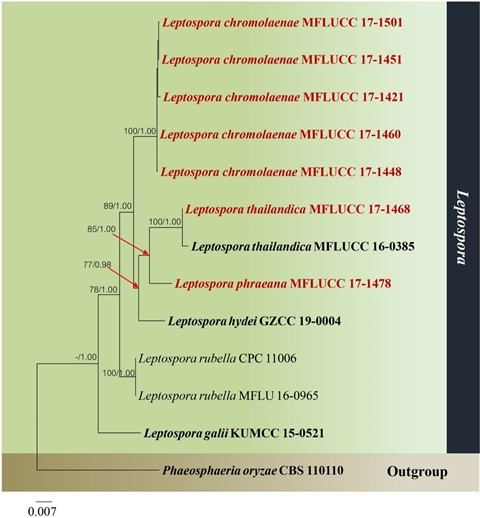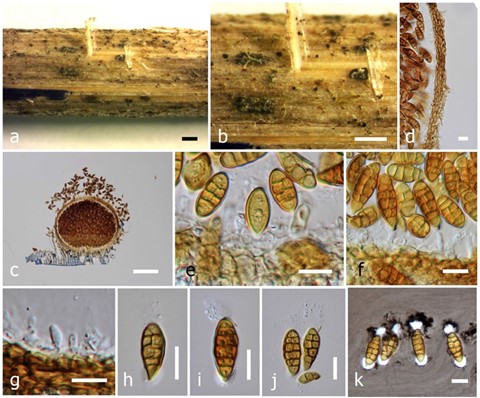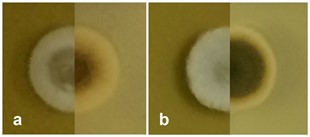Murichromolaenicola chromolaenae Mapook & K.D. Hyde, sp. nov.
MycoBank number: MB 557340; Index Fungorum number: IF 557340, Facesoffungi number: FoF 07807; Fig. 59
Etymology: Name reflects the host genus Chromolaena, from which this species was isolated.
Holotype: MFLU 20-0327
Saprobic on dead stems of Chromolaena odorata. Sexual morph: Undetermined. Asexual morph: Conidiomata 200–235 µm high × 195–230(–260) µm diam. ( x̄ = 228 × 226 µm, n = 5), pycnidial, solitary, immersed to semi-immersed in the host surface, uni-loculate, globose, yellowish brown to brown. Pycnidial wall 10–20 µm wide, comprising 4–5 layers of thick-walled, dense, yellowish brown to brown cells of textura angularis. Conidiophores reduced to conidiogenous cells. Conidiogenous cells phialidic, ampulliform to cylindrical, hyaline, unbranched. Conidia 14–25 × 6.5–11 μm ( x̄ = 20.5 × 8.5 µm, n = 50), ellipsoid to broadly fusiform, muriform, 5–7-transversely septate, with 1–2-vertical septa, small guttule, not constricted at the septa, yellowish brown to brown, with polar appendages, observed clearly when mounted in Indian ink.
Culture characteristics: Conidia germinating on MEA within 24 h at room temperature and germ tubes produced from both ends. Colonies on MEA circular, mycelium crateri- form, undulate, cultures white with greyish from the centre of the colony at the surface, olivaceous from the centre of the colony in reverse with creamy-white at the margin (Fig. 60b).
Pre-screening for antimicrobial activity: Murichromolaenicola chromolaenae (MFLUCC 17-1489) showed antimicrobialactivity against E. coli with a 17 mm inhibition zone, when compared to the positive control (9 mm), but no inhibition of B. subtilis and M. plumbeus.
Material examined: THAILAND, Chiang Rai Province, Doi Pui, on dead stems of Chromolaena odorata, 2 April 2017, A. Mapook (DP88, MFLU 20-0327, holotype); ex- type culture MFLUCC 17-1489.
GenBank numbers: LSU: MN994560, ITS: MN994583, SSU: MN994606, TEF1: MN998164
Notes: In a BLASTn search of NCBI GenBank, the closest match with the ITS sequence of Murichromolaenicola chromolaenae (MFLUCC 17-1489, ex-holotype) with 90.65% similarity was Phaeosphaeria herpotrichoides (strain CBS 306.71, MH860137). The closest match with the LSU sequence with 98.90% similarity was Allophaeosphaeria muriformia (strain MFLUCC 13-0277, KX910089). The closest match with the SSU sequence with 99.82% similarity was Phaeosphaeria avenaria f. sp. triticae (strain ATCC 26370, EU189210), while the closest match with the TEF1 sequence with 99.82% similarity was Wojnowicia italica (strain MFLU 14-0732, KX430003). In the present phylogenetic analysis, M. chromolaenae clusters with M. chiangraiensis (MFLUCC 17-1488) with high bootstrap support (100% ML and 1.00 BYPP, Fig. 52). Although we could not compare the morphological characteristics of these species; M. chromolaenae is found as asexual morph in nature, while M. chiangraiensis is found as sexual morph in nature and we could not obtain its asexual morph in culture, but they differ in culture characteristics on MEA (Fig. 60). A comparison of the TEF1 gene region of M. chromolaenae and M. chiangraiensis reveals 41 base pair differences (4.7%) across 872 nucleotides. Therefore, M. chromolaenae is described as a new species based on phylogeny.

Fig. 52 Phylogram generated from maximum likelihood analysis based on combined dataset of LSU, ITS, SSU, TEF1 and RPB2 sequence data. Thirteen strains are included in the combined sequence analysis, which comprise 4416 characters with gaps. Tree topology of the ML analysis was similar to the BYPP. The best scoring RAxML tree with a final likelihood value of − 8333.195072 is presented. The matrix had 327 distinct alignment pat- terns, with 24.82% of undetermined characters or gaps. Estimated base frequencies were as follows: A = 0.252190, C = 0.233838, G = 0.264447, T = 0.249525; substitution rates: AC = 1.127465, AG = 2.895211, AT = 2.022869, CG = 0.534488, CT = 8.448227, GT = 1.000000; gamma distribution shape parameter α = 0.020000. Boot- strap support values for ML equal to or greater than 60% and BYPP equal to or greater than 0.90 are given above the nodes. Newly generated sequences are in dark red bold and type species are in bold. Phaeosphaeria oryzae (CBS 110110) is used as outgroup taxon

Fig. 59 Murichromolaenicola chromolaenae (holotype) a, b Appearance of conidiomata on substrate. c Section through conidioma. d Peridium. e–g Conidiogenous cells and devel- oping conidia. h–j Conidia. k Conidia with polar append- ages in Indian ink. Scale bars: a, b = 500 µm, c = 100 µm, d–k = 10 µm

Fig. 60 Culture characteristics on MEA: a Murichromolaenicola chiangraiensis (MFLUCC 17-1488). b Murichromolaenicola chromolaenae (MFLUCC 17-1489)
